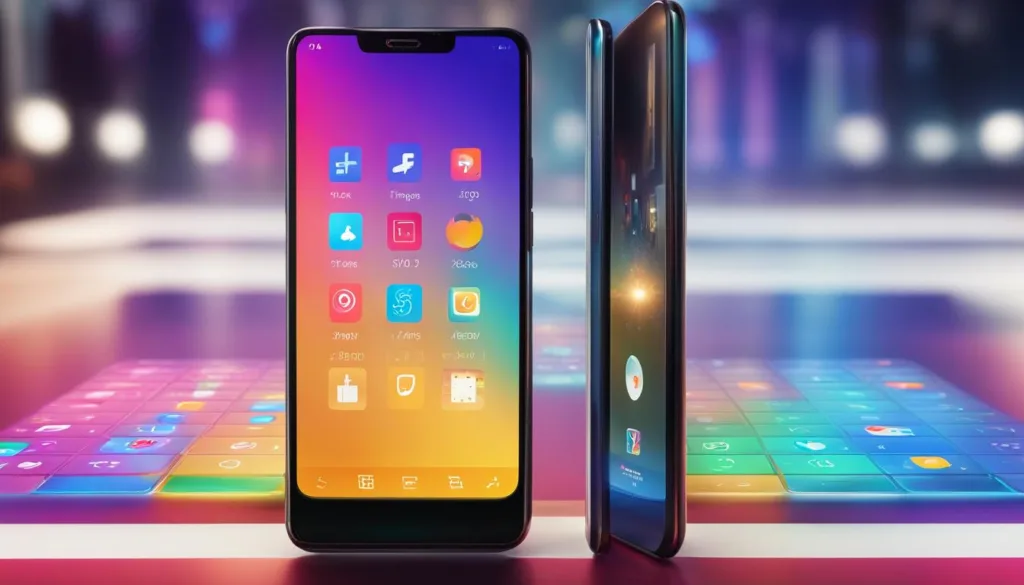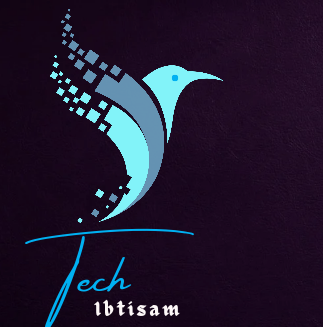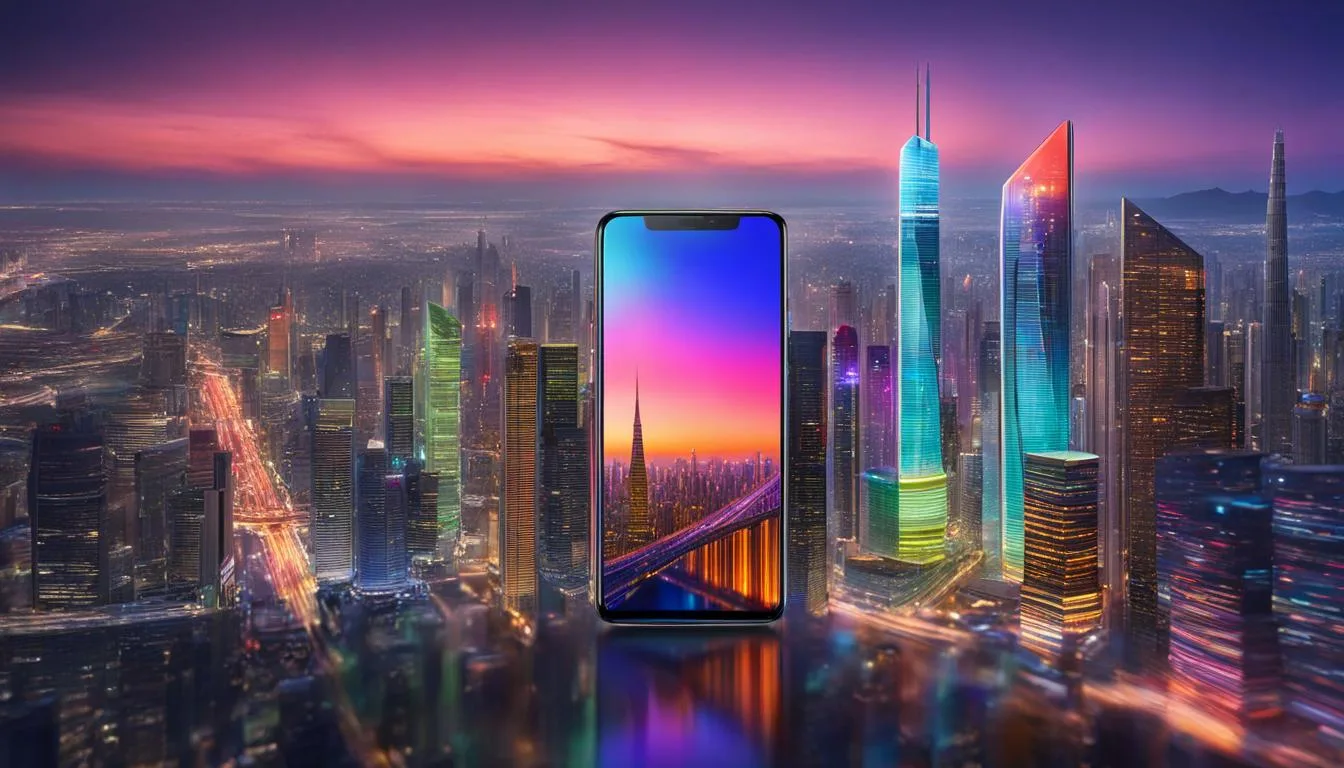When it comes to smartphones, there are two dominant giants in the industry that stand out from the rest: iPhone and Android. While both offer unique features and benefits, choosing the right one for you can be tricky. That’s why we’ve created this comprehensive guide to help you decide which smartphone giant, iPhone or Android, is the perfect match for your lifestyle.
Key Takeaways:
- Understand the differences between iPhone and Android ecosystems to make an informed decision
- Consider factors such as design, user interface, app stores, security, and camera technology
- Assess the battery life, performance, price ranges, and personalization options of each platform
- Choose the smartphone giant that aligns with your priorities, preferences, and requirements
- Both iPhone and Android have their strengths and weaknesses, ultimately the decision falls on individual needs and personal preference
Understanding the iPhone
Apple’s iPhone has revolutionized the world of smartphones since its debut in 2007. The iPhone is known for its sleek and iconic design, user-friendly interface, and top-of-the-line hardware and features. What sets the iPhone apart from other devices is the proprietary iOS operating system, which offers a seamless and intuitive user experience.
With iOS, you can access Apple’s exclusive ecosystem of apps, services, and accessories, such as Apple Pay, iCloud, and the App Store. Apple’s commitment to user privacy and security is evident through features such as Touch ID and Face ID, which allow users to securely access their devices and authenticate transactions.
The iPhone also boasts exceptional camera quality, with advanced features such as Night Mode and Deep Fusion, perfect for capturing stunning photos and videos. In addition, the integration with other Apple devices such as iPad, MacBook, and Apple Watch, makes for a seamless and integrated experience.
Unveiling the Android
The Android operating system is an open-source platform developed by Google. With its versatility and customization options, Android offers a user experience that is quite different from that of iPhone. Whether you’re a tech-savvy user or someone who needs a smartphone for basic communication, Android has something to offer for everyone.
| Features | Advantages of Android |
|---|---|
| Open-Source | Android is an open-source platform, making it accessible and customizable. |
| Google Play Store | The Google Play Store offers a vast collection of apps, games, and other media. |
| Customization | Android allows for extensive customization of themes, widgets, and other settings. |
| Hardware Options | There are many hardware options available for Android devices at different price ranges. |
| Integration with Google Services | Google services such as Drive, Gmail, and Google Assistant integrate seamlessly with Android. |
Overall, Android has continued to evolve and improve over the years, providing users with a robust and unique user experience. From customization options to versatile hardware choices, Android offers a different perspective that suits different lifestyles.

Design and Aesthetics
Design and aesthetics are undoubtedly some of the most crucial aspects when choosing a smartphone. Both iPhone and Android devices offer unique styles and materials that appeal to different users.
iPhone, known for its sleek and sophisticated design, boasts a unibody aluminum or stainless steel frame with a glass front and back. Apple’s attention to detail is evident in the clean lines and seamless integration of hardware and software.
On the other hand, Android devices offer a wider variety of designs and materials. From the Samsung Galaxy’s curvaceous edges to the Google Pixel’s matte finish, there’s something for everyone. Plus, Android devices tend to feature larger screens, allowing for a more immersive visual experience.
Of course, aesthetics aren’t just about looks; they’re also about how a device feels in your hand. Both iPhone and Android devices prioritize the user experience, with slim and lightweight designs that are comfortable to hold and use for extended periods.
Materials Comparison
| Brand | Model | Material |
|---|---|---|
| Apple | iPhone 12 | Ceramic Shield front, aerospace-grade aluminum edges, glass back |
| Pixel 5 | 100% recycled aluminum enclosure, bio-resin | |
| Samsung | Galaxy S21 Ultra | Gorilla Glass Victus front and back, aluminum frame |
Ultimately, the design and aesthetics of a smartphone are a matter of personal preference. Consider the style, material, and overall appeal when choosing between iPhone and Android devices.
User Interface and User Experience
When it comes to user interface and user experience, iPhone and Android have different approaches. iPhone’s iOS is known for its user-friendly design and intuitive navigation, **making it accessible even to first-time users**. The operating system’s clean layout and organized structure provide a seamless experience, allowing users to accomplish their tasks quickly. However, some users find iOS to be restrictive, as it limits customization options. **Android, on the other hand, offers a more open platform, allowing users to customize the interface and tailor it to their liking**.
Overall, both operating systems have their strengths and weaknesses when it comes to user interface and user experience. iPhone’s simplicity and ease of use make it suitable for many, while Android’s versatility and customization options cater more towards power users and tech-savvy individuals.

App Stores and Ecosystem
One of the critical features of any smartphone is the app store. Both iPhone and Android offer a vast range of applications that cater to different interests and functionalities. Apple’s App Store is known for its quality and security standards. Users can choose from more than 2 million apps, including free and paid versions.
On the other hand, Google Play Store, available on Android devices, offers around 3 million apps, including games, productivity tools, and social media apps.
Another element that sets iPhone and Android apart is the ecosystem they offer. The iPhone ecosystem is tightly controlled by Apple, allowing for seamless integration between their devices. The ecosystem includes Apple Music, Apple TV+, iCloud, and other services that enhance the user experience.
Android, being an open-source operating system, offers a more flexible ecosystem, allowing users to customize their devices to a greater extent. Additionally, Android offers integration with Google suite apps such as Google Assistant, Google Drive, and Google Photos.
Ultimately, your choice between iPhone and Android will depend on your preference for app variety and ecosystem integration. Consider your priorities and needs while choosing a device.
App Store Comparison:

| Features | iPhone | Android |
|---|---|---|
| Number of Apps | 2 million | 3 million |
| Quality Standards | High | N/A |
| App pricing | Higher end | Varies |
| App discovery | Less personalized | More personalized |
| Ecosystem Integration | Seamless | Flexible |
Whichever ecosystem you choose, both iPhone and Android offer a wide range of apps that cater to diverse interests and needs. The app store difference is more about quality and security standards than quantity of apps. Meanwhile, consider the ecosystem differences and what suits you when choosing your device.
Security and Privacy
When it comes to smartphones, data protection and device security are key concerns for users. Both iPhone and Android have implemented various measures to safeguard user information, but which one does it better?
Apple’s iPhone provides a highly secure system thanks to its closed-source operating system, which makes it difficult for hackers to exploit security vulnerabilities. Additionally, iPhone devices come equipped with the latest encryption technology, such as biometric authentication features, to ensure data privacy. The tech giant also restricts app developers from accessing user information without explicit consent.
On the other hand, Android’s open-source nature makes it more susceptible to security breaches. However, Google has implemented several measures to counter this. For instance, devices running on Android 6.0 and above employ the Android verified boot (AVB) process, which checks the device’s software for malicious modifications. Android devices also provide granular control over app permissions, enabling users to limit the amount of data that individual apps can access.
Despite the measures taken by both operating systems, the safest choice depends on the user’s requirements and usage patterns. If maximum security and data privacy are essential, the iPhone may be the better choice. Alternatively, if users prioritize customizability and prefer more control over app permissions, Android may be the better option.
Camera Technology
When it comes to camera technology, iPhone and Android devices have increasingly advanced over the years, offering exceptional image quality and unique features. Let’s delve into the details and compare the camera technologies of these smartphone giants.
iPhone
Apple’s iPhone is well-known for its exceptional camera technology that offers impressive image quality and versatile features. The latest iPhone models feature up to three cameras, including an ultra-wide lens, providing users with a broader field of view and more creative options. Additionally, the Night mode of the iPhone’s camera dramatically improves low-light photography. The Smart HDR feature is another standout, which captures more details and color, especially in high-contrast scenes. The iOS operating system also comes with great built-in editing tools, enabling users to edit their photos professionally without needing a third-party app.
“The iPhone’s camera technology is unparalleled, producing excellent image quality with a wide range of features. It is the ideal choice for photography enthusiasts.”
Android
Android-powered smartphones are known for their innovative camera technologies that produce spectacular photos. Unlike iPhone devices, most Android devices offer a wide variety of camera setups, ranging from dual-lens to quad-lens cameras, each with its own unique capabilities and features. Google’s Pixel devices are particularly known for their exceptional lens quality, featuring advanced low-light capabilities, high-dynamic-range imaging, and excellent portrait mode. Additionally, most Android devices sport a manual mode, offering users extensive control over the camera’s settings, such as exposure, shutter speed, and ISO. The Android operating system also provides users access to a vast range of third-party apps, enabling them to take their photography to the next level.
“Android devices offer diverse camera setups, from dual to quad-lens cameras, and the manual mode offers users complete control over the camera’s settings, making it a go-to choice for most photographers.”
| iPhone | Android | |
|---|---|---|
| Number of Lenses | Up to 3 | Dual-lens to quad-lens |
| Low-Light Performance | Excellent | Advanced |
| Manual Mode | No | Yes |
| Built-in Editing Tools | Yes | No |
Both iPhone and Android devices have their strengths when it comes to camera technology. While the iPhone’s camera technology is unparalleled with exceptional image quality, editing tools, and a reputation for producing professional-looking photos even when the conditions are not ideal, Android devices offer versatile features like manual mode, diverse camera setups, and advanced low-light performance.
Battery Life and Performance
When it comes to choosing a new smartphone, assessing battery life and performance is crucial. In terms of battery life, Android phones tend to have larger battery capacities than iPhone, meaning they can last longer with heavy use. However, Apple devices are known for their optimization, which allows them to manage battery life effectively.
In terms of performance, both iPhone and Android have their strengths. However, iPhones tend to offer a more seamless and efficient user experience, thanks to the iOS operating system optimization. On the other hand, Android devices come in a variety of models and offer more customization options, which can affect performance.
If you’re looking for an Android device with top-notch battery life, consider phones such as the Samsung Galaxy S21 Ultra or the Google Pixel 5. For those seeking an iPhone that performs exceptionally well, the iPhone 12 Pro Max is a top choice.
“My iPhone lasts a full day without needing to be charged, even with heavy use. The performance is smooth, and I love how the device manages apps and battery life.” – Emma, iPhone user
Battery Life and Performance Table
| Phone Model | Battery Capacity (mAh) | Battery Life (hours) | Performance |
|---|---|---|---|
| iPhone 12 Pro Max | 3687 | 10-11 | Excellent |
| Samsung Galaxy S21 Ultra | 5000 | 12-13 | Good |
| Google Pixel 5 | 4080 | 10-11 | Good |
Table: Comparison of battery capacity, battery life, and performance of select iPhone and Android devices. Capacity and life data are approximate and may vary based on usage and other factors.
Price Range and Affordability
When it comes to purchasing a smartphone, one of the most significant factors to consider is price. Both iPhone and Android offer a range of devices at various price points, allowing users to find an option that suits their budget.
| iPhone | Android | |
|---|---|---|
| Upfront Costs | Generally more expensive, with the latest models starting at $699 for the iPhone 11 and $999 for the iPhone 11 Pro. | The upfront costs of Android devices can vary widely, with budget devices available for under $200 and high-end models such as the Samsung Galaxy S21 Ultra starting at $1,199. |
| Long-Term Expenses | While upfront costs for iPhones may be higher, long-term expenses can be lower due to the devices’ longevity and the ability to receive software updates for several years. | While some Android devices may be cheaper upfront, long-term expenses can be higher due to shorter software update cycles and the need to replace devices more frequently. |
| Different Budgets | iPhone offers a variety of options to fit different budgets, such as the iPhone SE priced at $399 and the iPhone XR at $499. | Android provides a vast range of devices suited to different budgets, making it a more affordable option for users. |
Ultimately, when considering price range and affordability, both iPhone and Android offer options for users with different budgets. It’s essential to weigh upfront costs against long-term expenses and consider which device is the best fit for your lifestyle.
Personalization and Customization
One of the most exciting aspects of owning a smartphone is making it truly your own. With both iPhone and Android devices, you can customize your settings, the home screen, and the overall look and feel of your device.
iPhone users have access to a wide range of customizable options through the iOS operating system. You can adjust your home screen layout, add widgets, and choose from a variety of wallpapers to make your device unique. iOS also offers a dark mode option, which can be easier on the eyes and provide a sleek look for your device.
Android users, on the other hand, have even more customization options through the Google Play Store. You can download themes, launchers, and icon packs to completely transform the appearance of your smartphone. And with widgets, you can access your favorite apps right from the home screen.
Ultimately, personalization and customization come down to personal preference and what makes the most sense for your lifestyle. Whether you choose iPhone or Android, you can make your device a reflection of your style and personality.
Conclusion
After diving into the world of iPhone vs Android, it’s clear that there are pros and cons for both ecosystems. Ultimately, the choice between iPhone and Android comes down to your personal needs and preferences.
If you value a sleek and stylish design, seamless user experience, and a wide range of high-quality camera features, then iPhone might be the perfect fit for you.
If, on the other hand, you prefer a more customizable user interface, greater control over app installations, and more affordable devices, Android could be the right choice.
Additionally, if security and privacy are a top priority, then iPhone might be the way to go. However, if you prioritize battery life and overall performance, then Android devices might be a better fit.
Ultimately, whichever ecosystem you choose, both iPhone and Android offer a variety of features and benefits that can enhance your smartphone experience. So, weigh your options carefully, and choose the device that’s right for you.
FAQ
How do iPhone and Android differ?
iPhone and Android differ in terms of their operating systems, with iPhone running on iOS developed by Apple and Android running on an operating system developed by Google. They also differ in design, app stores, security measures, camera technology, battery life, performance, and price range.
What are the design and aesthetics of iPhone and Android?
iPhone and Android devices have unique design styles and aesthetics. iPhone devices are known for their sleek and modern look, typically crafted from premium materials such as glass and metal. On the other hand, Android devices offer a wider range of design options, with various shapes, sizes, and materials to suit different preferences.
How do the user interfaces and user experiences of iPhone and Android compare?
The user interface and user experience of iPhone and Android differ in terms of ease of use and customization options. iPhone offers a more streamlined and user-friendly interface, with a focus on simplicity. Android, on the other hand, provides a high level of customization, allowing users to personalize their devices according to their preferences.
What is the difference in app stores and ecosystems between iPhone and Android?
iPhone has the App Store, which offers a vast selection of applications curated and regulated by Apple. Android, on the other hand, has the Google Play Store, which also provides a wide range of applications. Android devices have a more open ecosystem, allowing users to access apps from third-party sources as well.
How do iPhone and Android ensure security and privacy?
Both iPhone and Android take measures to ensure security and privacy. iPhone has a reputation for its strict security measures, such as the use of Face ID or Touch ID for authentication and end-to-end encryption for messaging. Android, on the other hand, offers robust security features and permissions control, allowing users to manage their privacy settings.
How does the camera technology of iPhone and Android compare?
The camera technologies of iPhone and Android devices vary in terms of features and image quality. iPhone cameras are known for their exceptional image processing and ease of use, while Android devices often offer a wider range of camera configurations, including options for manual control and advanced shooting modes.
What is the difference in battery life and performance between iPhone and Android?
The battery life and overall performance of iPhone and Android devices can vary. iPhone devices are known for their optimized performance and efficient power management, providing a seamless user experience. Android devices offer a wide range of options, and battery life and performance can vary depending on the device and manufacturer.
How do the price range and affordability of iPhone and Android compare?
The price range and affordability of iPhone and Android devices differ. iPhones are generally considered more expensive, especially for the latest models. Android devices, on the other hand, offer a wider range of options with varying price points, making them more accessible and affordable for different budget ranges.
Can I personalize and customize iPhone and Android?
Both iPhone and Android devices offer personalization and customization options. iPhone allows users to personalize certain aspects such as wallpapers, app layouts, and notification settings. Android, on the other hand, provides more extensive customization options, including the ability to install custom themes, launchers, and tweak various system settings.

